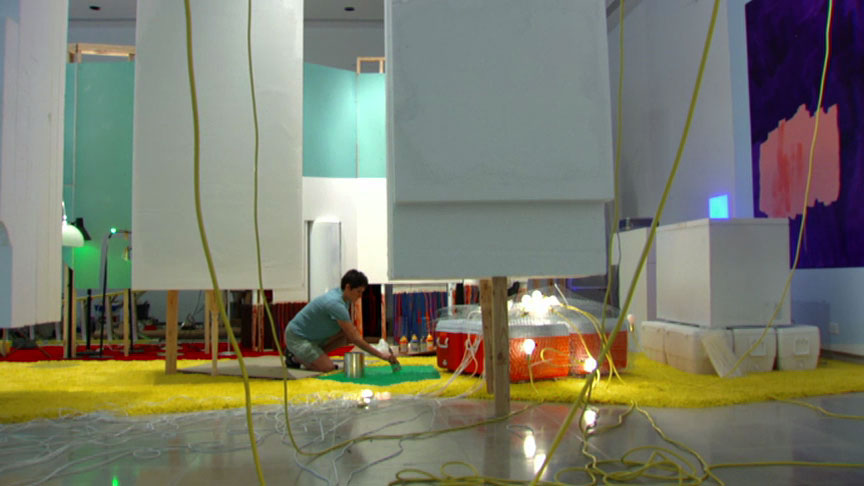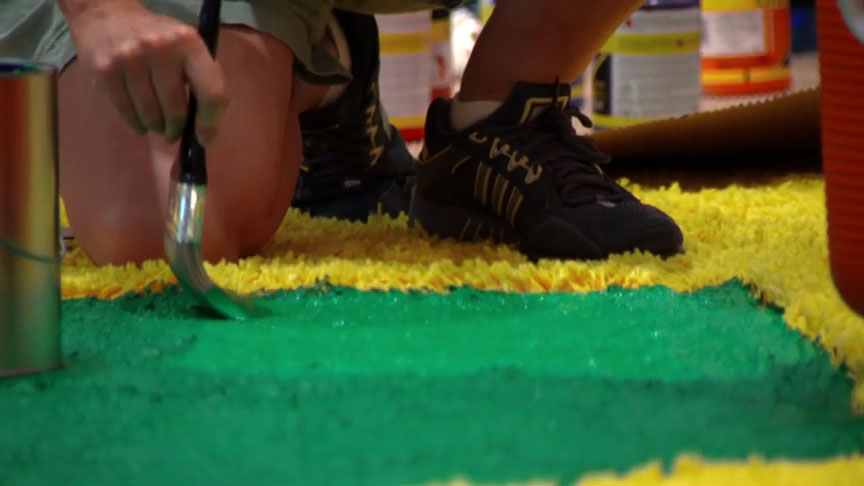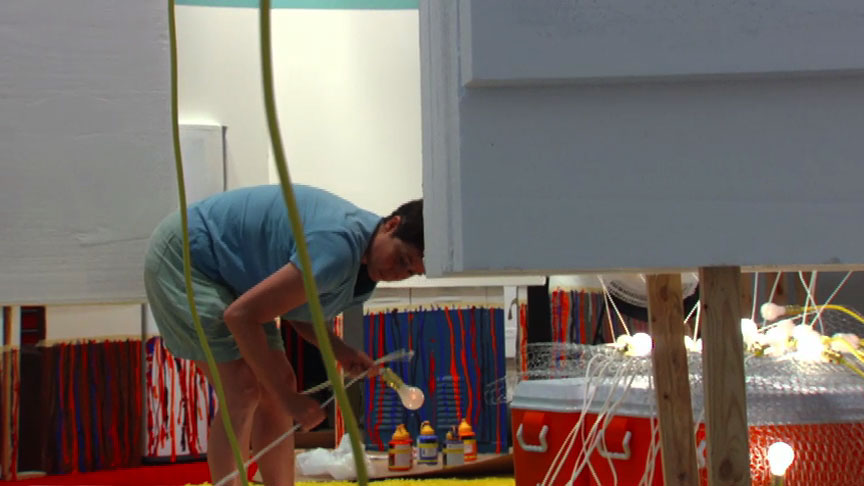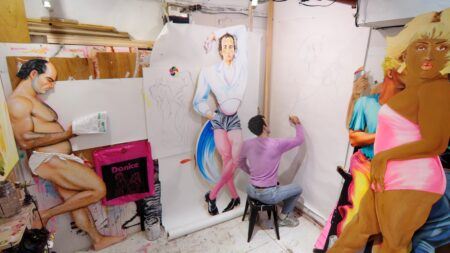Interview
Interests and Influences

Jessica Stockholder installing Sam Ran Over Sand or Sand Ran Over Sam (2004) at Rice University Art Gallery, Houston, TX, 2004. Production still from the Art in the Twenty-First Century Season 3 episode, Play. © Art21, Inc. 2005.
Jessica Stockholder discusses her work’s relation to play, fun, and Abstract Expressionism.
ART21: Can you talk about your work in relationship to fun?
STOCKHOLDER: Sometimes it’s fun, and there are moments when it’s exhilarating. In the end, it’s a kind of pleasure, at least in part—but it’s not always fun making it.
ART21: What about play?
STOCKHOLDER: Kids’ play is a kind of learning and thinking that doesn’t have a predetermined end. I think I’m involved in that.
ART21: Talk about the piece you describe in the accompanying text as “a Yellow Brick Road.”
STOCKHOLDER: I didn’t think so consciously about the Yellow Brick Road from The Wizard of Oz. When I make these pieces, I don’t have a literary story in mind. I work thinking about the experience of color and space—what things are going to look like visually—and the excitement and impact there is in that, for me. Afterwards, I can put words to what I’m doing.
I wrote about this piece and used the Yellow Brick Road from The Wizard of Oz as some kind of poetic text. I think all those kinds of fantasy fictions have resonance with what I do. I once titled a piece The Lion, The Witch, and The Wardrobe. In that story, the kids disappear into another world through a closet door. I think my work is about this possibility for some world other than the one we experience. It’s like going into a mundane closet and disappearing into something that’s extraordinary and full of fantasy.
ART21: Can you explain the title for the work, Sam Ran Over Sand or Sand Ran Over Sam?
STOCKHOLDER: The title? Dr. Seuss immediately comes to everybody’s mind. Dr. Seuss is very playful with sounds of words as well as their meanings—the way words sound and play with each other internally is as important as what is being told. That resonates with my work. I’m as interested in formal play and how that intersects significance as in what things mean. So, I do like that reference in the title. But it’s also descriptive of something I am thinking about in my work, generally—and in this work—about how things have character. I don’t think it’s fair to say that my work is “just” formal. I don’t think anything is “just” formal; I think formal things have significance. And the word narrative isn’t the right word to use in relationship to what I do. I don’t construct narratives.
I haven’t found the right word, but there is some kind of storytelling, for lack of a better word. There are evocations—floating significances—that combine in a poetic way. That title posits Sam as a character, and the sand as a character. Things have character. So, I’m interested in how the character of things might function as a protagonist, in what isn’t a narrative, here.
What I find most interesting about people is that the structure of meaning and significance that each of us lives with isn’t easy to articulate. That’s why storytelling is so important—and art making—because in those forums, as opposed to something like an academic essay, we create structures that are difficult to pin down, and we accommodate floating kinds of significance.

Jessica Stockholder installing Sam Ran Over Sand or Sand Ran Over Sam (2004) at Rice University Art Gallery, Houston, TX, 2004. Production still from the Art in the Twenty-First Century Season 3 episode, Play. © Art21, Inc. 2005.
ART21: Describe your use of the icebox in the piece.
STOCKHOLDER: I’ve used refrigerators in my work more than once. I’m interested in temperature. I’ve used things that make heat and things that are cool. In this case, this is a freezer chest. It’s a white cube, like the gallery is a white cube. I’ve always enjoyed refrigerators and freezers because they are the place of food in a house. And food and cooking have to do with loving and giving in a family. Also freezers and refrigerators are cold and frozen, as an emotional mirror that has to do with withholding and not loving. So, for me they embody that duality—which is also in the gallery. Institutions of art are full of possibility and extraordinary feeling. They also put art in a place of remove; and in some ways, it has less power than if it weren’t removed.
ART21: The icebox—it’s perfect.
STOCKHOLDER: Yes, it’s very perfect. It’s a beautiful object, and it’s full of geometry. I just love that.
ART21: Talk about your love of Matisse.
STOCKHOLDER: Matisse has clearly been an influence on me. I love color. Matisse is completely involved in color. It’s hard to articulate why color is so exciting or wonderful, but I think it can be. Also, in my work, I’m interested in systems—how things are organized and then how the system breaks down and becomes eccentric or quirky. How a thinking process can meander in unpredictable ways, in contrast to a system that’s been planned and shared amongst people. I think Matisse’s paintings occupy that place, too.

Jessica Stockholder installing Sam Ran Over Sand or Sand Ran Over Sam (2004) at Rice University Art Gallery, Houston, TX, 2004. Production still from the Art in the Twenty-First Century Season 3 episode, Play. © Art21, Inc. 2005.
ART21: Can you explain the purple and pink wall in this piece?
STOCKHOLDER: I’m interested in Abstract Expressionism. Through my life, that’s been kind of taboo. Abstract Expressionism has been debunked and sneered at; the idea that expressing oneself is interesting to anybody else has been laughed at. And I understand the reasons for that. But I think, nevertheless, that each one of us has personal reasons for making things, and that the work wouldn’t be interesting or powerful if we didn’t. Each one of us is a subject, a person. And each one of us does have handwriting. You know, we have a way of making marks, and that’s not uninteresting.
I don’t think my person is what’s interesting about my work, but what I make of my person, how I think of my person and manage my person in relationship to the culture we share, is of interest, because we all have to do that. Everybody has to manage their person in relationship to others. And so, in this work, this drip and the hand of the brush and everything, it’s my handwriting, mark making. It’s very self-conscious.
I’m aware of how the work intersects with a history and critique of Abstract Expressionism. It also refers to Mondrian, Agnes Martin, and minimalism. I don’t think my work would exist without minimalism, though it doesn’t appear minimal. My work points at and refers to a whole history—a myriad of different people and structures that the work rests on.
ART21: What about the quality of drawing in space, in your work?
STOCKHOLDER: Other people have done that. Fred Sandback drew in space with string. I’m not the first one.
These cords that draw in space are coming from the lighting fixtures in the wall, in the ceiling. They describe a kind of grid in space. The wires form a grid that mirrors the grid of the architecture. And then there’s a grid of stone tile on the floor, and these light bulbs make a chaotic grid that mirrors the grid of the wires in the floor. My work rests on a formal pattern-making. These wires, by drawing in space, also carve up that air. They describe the volume of air as significant, next to this volume of Styrofoam and the color volume on the floor.
ART21: What about the green and the red?
STOCKHOLDER: I’m always playing with the way that things are pictorial from certain points of view, and then more physical. So, it’s less about picture making, though I don’t think that disappears entirely, and more about your body—this orange color kind of floating onto your body and filling the air, and how that’s similar to light generally filling the air—and the feeling of the Styrofoam, the weight of the Styrofoam next to that weight of that color. The green is flat; the Styrofoam is white but not flat. But that green has an illusion of volume or space. I like to put together those things that have illusion of weight and space with things that have real weight and space.
So, here we have a real rectangle of orange and white, a volume of it, sitting next to a flat, kind of illusionistic volume of green. And red and green—generally I’ve used a lot of red and green. When I first started painting and drawing, almost everything was red and green. There’s a kind of optical buzz between them. And I think there’s something very charged and almost sexual about red and green.
ART21: And the notion of mapping?
STOCKHOLDER: The thing that comes to mind is how memory functions. Moving through the work, it matters that you remember what’s on the other side, how it looks from over there. There’s a kind of mapping of memory that this addresses. I think mapping and composition have something to do with one another. Composition has been jeered at over the years, in terms of art making and painting. But I think composition is everywhere: you don’t make a car, clean your house, or have an office without being involved in composition.

Jessica Stockholder installing Sam Ran Over Sand or Sand Ran Over Sam (2004) at Rice University Art Gallery, Houston, TX, 2004. Production still from the Art in the Twenty-First Century Season 3 episode, Play. © Art21, Inc. 2005.
ART21: What about the connections to home, lamps, et cetera?
STOCKHOLDER: I use a lot of domestic objects, and I use other kinds of objects, too. I always worry talking about the domestic in my work because people very readily tie that to being a woman. We all live in homes; we all have domestic lives. It’s part of being a person. My work has to do with the domestic and the private, but it also has to do with public space.
ART21: Anything else you want to debunk?
STOCKHOLDER: People often describe my work as being concerned with trash or garbage. I use castoff things and new, bright, and shiny things. My work is not about a particular kind of object so much as it’s about stuff in general. I’m not interested in having the work be caught in one kind of stuff.
ART21: There’s a kind of classical way all of this stuff is arranged.
STOCKHOLDER: I think my work is very classical, which is sort of ironic to me. It started out as a kind of elbowing the art institution, being upset at how art’s muffled because it’s precious and packaged and put on a pedestal. My work participates in a shared history of poking at the container of the gallery. Of course, we need art institutions. We don’t communicate with one another and have a place to share work if we don’t have galleries and museums. But I think their particular nature needs to be addressed, understood, and played with in people’s work.

Jessica Stockholder installing Sam Ran Over Sand or Sand Ran Over Sam (2004) at Rice University Art Gallery, Houston, TX, 2004. Production still from the Art in the Twenty-First Century Season 3 episode, Play. © Art21, Inc. 2005.
ART21: Can you expand on that?
STOCKHOLDER: I think that my work is classical but also very contemporary. I do a lot of shopping at Home Depot. I don’t know how much I want to give credit to all those different big conglomerates, but stuff is cheap and easy to buy, and I participate in that. I use material that’s inexpensive, readily available. It’s really a pleasure that we have all this stuff around us. I love plastic; I think it’s gorgeous, and I love it. All of these objects are full of design and other people’s thinking, and I ride on the backs of that. I think that my work engages the means of production that we live with, even while it embodies things from a long time ago.
ART21: What about the temporary aspect of your work?
STOCKHOLDER: The installation work won’t exist past the end of the show. In a way, it’s a very slow performance. Not very much happens here; everything is kind of still and static. It has a beginning, a middle, an end, and it’s over. It’s a material performance.
This interview was originally published on PBS.org in September 2005 and was republished on Art21.org in November 2011.



